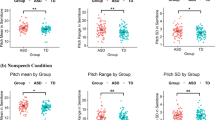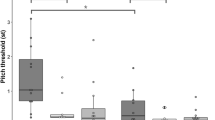Abstract
Tone language experience benefits pitch processing in music and speech for typically developing individuals. No known studies have examined pitch processing in individuals with autism who speak a tone language. This study investigated discrimination and identification of melodic contour and speech intonation in a group of Mandarin-speaking individuals with high-functioning autism. Individuals with autism showed superior melodic contour identification but comparable contour discrimination relative to controls. In contrast, these individuals performed worse than controls on both discrimination and identification of speech intonation. These findings provide the first evidence for differential pitch processing in music and speech in tone language speakers with autism, suggesting that tone language experience may not compensate for speech intonation perception deficits in individuals with autism.




Similar content being viewed by others
References
Aiken, E., Shennum, W., & Thomas, G. (1974). Memory processes in the identification of pitch. Perception and Psychophysics, 15(3), 449–452.
Alexander, J. A., Bradlow, A. R., Ashley, R. D., & Wong, P. (2008). Music-melody perception in tone-language and non-tone-language speakers. Poster presented at the 156th Meeting of Acoustical Society of America, Miami, FL.
American Psychiatric Association. (1994). Diagnostic and statistical manual of mental disorders (4th ed.). Washington, DC: American Psychiatric Association.
American Psychiatric Association. (2013). Diagnostic and statistical manual of mental disorders (5th ed.). Washington, DC: American Psychiatric Association.
Bent, T., Bradlow, A. R., & Wright, B. A. (2006). The influence of linguistic experience on the cognitive processing of pitch in speech and nonspeech sounds. Journal of Experimental Psychology: Human Perception and Performance, 32(1), 97–103.
Bidelman, G. M., Hutka, S., & Moreno, S. (2013). Tone language speakers and musicians share enhanced perceptual and cognitive abilities for musical pitch: Evidence for bidirectionality between the domains of language and music. PLoS ONE, 8(4), e60676.
Boddaert, N., Chabane, N., Belin, P., Bourgeois, M., Royer, V., Barthelemy, C., & Zilbovicius, M. (2004). Perception of complex sounds in autism: Abnormal auditory cortical processing in children. American Journal of Psychiatry, 161(11), 2117–2120.
Bonnel, A., Mottron, L., Peretz, I., Trudel, M., Gallun, E., & Bonnel, A. M. (2003). Enhanced pitch sensitivity in individuals with autism: A signal detection analysis. Journal of Cognitive Neuroscience, 15(2), 226–235.
Bradley, E. D. (2012). Tone language experience enhances sensitivity to melodic contour. Paper presented at the meeting of Linguistic Society of America, Portland, OR.
Čeponienė, R., Lepistö, T., Shestakova, A., Vanhala, R., Alku, P., Näätänen, R., & Yaguchi, K. (2003). Speech-sound-selective auditory impairment in children with autism: They can perceive but do not attend. Proceedings of the National Academy of Sciences, 100(9), 5567–5572.
Deruelle, C., Schön, D., Rondan, C., & Mancini, J. (2005). Global and local music perception in children with Williams syndrome. NeuroReport, 16(6), 631–634.
Diehl, J. J., & Paul, R. (2012). Acoustic differences in the imitation of prosodic patterns in children with autism spectrum disorders. Research in Autism Spectrum Disorders, 6(1), 123–134.
Diehl, J. J., & Paul, R. (2013). Acoustic and perceptual measurements of prosody production on the profiling elements of prosodic systems in children by children with autism spectrum disorders. Applied Psycholinguistics, 34(1), 135–161.
Dunn, L. M., & Dunn, L. M. (1981). Peabody Picture Vocabulary Test-Revised. Circle Pines, MN: American Guidance Service.
Elsabbagh, M., Divan, G., Koh, Y.-J., Kim, Y. S., Kauchali, S., Marcín, C., & Fombonne, E. (2012). Global prevalence of autism and other pervasive developmental disorders. Autism Research, 5(3), 160–179.
Fombonne, E. (1999). The epidemiology of autism: A review. Psychological Medicine, 29(4), 769–786.
Foxton, J. M., Stewart, M. E., Barnard, L., Rodgers, J., Young, A. H., O’Brien, G., & Griffiths, T. D. (2003). Absence of auditory ‘global interference’ in autism. Brain, 126(12), 2703–2709.
Gervais, H., Belin, P., Boddaert, N., Leboyer, M., Coez, A., Sfaello, I., et al. (2004). Abnormal cortical voice processing in autism. Nature Neuroscience, 7(8), 801–802.
Giuliano, R. J., Pfordresher, P. Q., Stanley, E. M., Narayana, S., & Wicha, N. Y. Y. (2011). Native experience with a tone language enhances pitch discrimination and the timing of neural responses to pitch change. Frontiers in Psychology, 2, 146.
Green, D. M., & Swets, J. A. (1966). Signal detection theory and psychophysics. New York: Wiley.
Hautus, M. (1995). Corrections for extreme proportions and their biasing effects on estimated values of d’. Behavior Research Methods, Instruments, and Computers, 27(1), 46–51.
Heaton, P. (2003). Pitch memory, labelling and disembedding in autism. Journal of Child Psychology and Psychiatry, 44(4), 543–551.
Heaton, P. (2005). Interval and contour processing in autism. Journal of Autism and Developmental Disorders, 35(6), 787–793.
Heaton, P., Davis, R. E., & Happé, F. G. (2008a). Research note: Exceptional absolute pitch perception for spoken words in an able adult with autism. Neuropsychologia, 46(7), 2095–2098.
Heaton, P., Pring, L., & Hermelin, B. (1999). A pseudo-savant: A case of exceptional musical splinter skills. Neurocase, 5(6), 503–509.
Heaton, P., Williams, K., Cummins, O., & Happé, F. (2008b). Autism and pitch processing splinter skills: A group and subgroup analysis. Autism, 12(2), 203–219.
Hesling, I., Dilharreguy, B., Peppé, S., Amirault, M., Bouvard, M., & Allard, M. (2010). The integration of prosodic speech in high functioning autism: A preliminary fMRI study. PLoS ONE, 5(7), e11571.
Järvinen-Pasley, A., & Heaton, P. (2007). Evidence for reduced domain-specificity in auditory processing in autism. Developmental Science, 10(6), 786–793.
Järvinen-Pasley, A., Peppé, S., King-Smith, G., & Heaton, P. (2008a). The relationship between form and function level receptive prosodic abilities in autism. Journal of Autism and Developmental Disorders, 38(7), 1328–1340.
Järvinen-Pasley, A., Wallace, G. L., Ramus, F., Happé, F., & Heaton, P. (2008b). Enhanced perceptual processing of speech in autism. Developmental Science, 11(1), 109–121.
Jiang, C., Hamm, J. P., Lim, V. K., Kirk, I. J., Chen, X., & Yang, Y. (2012). Amusia results in abnormal brain activity following inappropriate intonation during speech comprehension. PLoS ONE, 7(7), e41411.
Jiang, C., Hamm, J. P., Lim, V. K., Kirk, I. J., & Yang, Y. (2010). Processing melodic contour and speech intonation in congenital amusics with Mandarin Chinese. Neuropsychologia, 48(9), 2630–2639.
Krug, D. A., Arick, J., & Almond, P. (1980). Behavior checklist for identifying severely handicapped individuals with high levels of autistic behavior. Journal of Child Psychology and Psychiatry, 21(3), 221–229.
Kuhl, P. K., Coffey-Corina, S., Padden, D., & Dawson, G. (2005). Links between social and linguistic processing of speech in preschool children with autism: Behavioral and electrophysiological measures. Developmental Science, 8(1), F1–F12.
Lee, Y.-S., Vakoch, D., & Wurm, L. (1996). Tone perception in Cantonese and Mandarin: A cross-linguistic comparison. Journal of Psycholinguistic Research, 25(5), 527–542.
Lepistö, T., Kujala, T., Vanhala, R., Alku, P., Huotilainen, M., & Näätänen, R. (2005). The discrimination of and orienting to speech and non-speech sounds in children with autism. Brain Research, 1066(1–2), 147–157.
Liu, F., Jiang, C., Thompson, W. F., Xu, Y., Yang, Y., & Stewart, L. (2012). The mechanism of speech processing in congenital amusia: Evidence from Mandarin speakers. PLoS ONE, 7(2), e30374.
Liu, F., & Xu, Y. (2005). Parallel encoding of focus and interrogative meaning in Mandarin intonation. Phonetica, 62(2–4), 70–87.
MacMillan, N. A., & Creelman, C. D. (2005). Detection theory: A user’s guide (2nd ed.). New Jersey: Lawrence Erlbaum Associates.
McCann, J., Peppé, S., Gibbon, F. E., O’Hare, A., & Rutherford, M. (2007). Prosody and its relationship to language in school-aged children with high-functioning autism. International Journal of Language and Communication Disorders, 42(6), 682–702.
Mottron, L., Peretz, I., & Ménard, E. (2000). Local and global processing of music in high-functioning persons with autism: Beyond central coherence? Journal of Child Psychology and Psychiatry, 41(8), 1057–1065.
Patel, A. D. (2003). Language, music, syntax and the brain. Nature Neuroscience, 6(7), 674–681.
Patel, A. D. (2008). Music, language, and the brain. New York: Oxford University Press.
Patel, A. D. (2012). Language, music, and the brain: A resource-sharing framework. In P. Rebuschat, M. Rohrmeier, J. Hawkins, & I. Cross (Eds.), Language and music as cognitive systems (pp. 204–223). Oxford: Oxford University Press.
Paul, R., Augustyn, A., Klin, A., & Volkmar, F. (2005). Perception and production of prosody by speakers with autism spectrum disorders. Journal of Autism and Developmental Disorders, 35(2), 205–220.
Peng, G., Zheng, H.-Y., Gong, T., Yang, R.-X., Kong, J.-P., & Wang, W. S.-Y. (2010). The influence of language experience on categorical perception of pitch contours. Journal of Phonetics, 38(4), 616–624.
Peppé, S., & McCann, J. (2003). Assessing intonation and prosody in children with atypical language development: The PEPS-C test and the revised version. Clinical Linguistics and Phonetics, 17(4–5), 345–354.
Peppé, S., McCann, J., Gibbon, F., O’Hare, A., & Rutherford, M. (2007). Receptive and expressive prosodic ability in children with high-functioning autism. Journal of Speech, Language, and Hearing Research, 50(4), 1015–1028.
Peretz, I. (2006). The nature of music from a biological perspective. Cognition, 100(1), 1–32.
Peretz, I., & Coltheart, M. (2003). Modularity of music processing. Nature Neuroscience, 6(7), 688–691.
Peretz, I., & Morais, J. (1987). Analytic processing in the classification of melodies as same or different. Neuropsychologia, 25(4), 645–652.
Peretz, I., & Morais, J. (1989). Music and modularity. Contemporary Music Review, 4(1), 279–293.
Pfordresher, P. Q., & Brown, S. (2009). Enhanced production and perception of musical pitch in tone language speakers. Attention, Perception, and Psychophysics, 71(6), 1385–1398.
Pisoni, D. (1975). Auditory short-term memory and vowel perception. Memory and Cognition, 3(1), 7–18.
Plantinga, J., & Trainor, L. J. (2005). Memory for melody: Infants use a relative pitch code. Cognition, 98(1), 1–11.
Raven, J., Raven, J. C., & Court, J. H. (1998). Raven manual: Section 3. Standard progressive matrices. Oxford: Oxford Psychologists Press.
Rutter, M., Bailey, A., & Lord, C. (2003). Social communication questionnaire. Los Angeles, CA: Western Psychological Services.
Stanutz, S., Wapnick, J., & Burack, J. A. (2014). Pitch discrimination and melodic memory in children with autism spectrum disorders. Autism, 18(2), 137–147.
Stevens, C. J., Keller, P. E., & Tyler, M. D. (2013). Tonal language background and detecting pitch contour in spoken and musical items. Psychology of Music, 41(1), 59–74.
Sun, X., Allison, C., Matthews, F., Sharp, S., Auyeung, B., Baron-Cohen, S., & Brayne, C. (2013). Prevalence of autism in mainland China, Hong Kong and Taiwan: A systematic review and meta-analysis. Molecular Autism, 4(1), 7.
Sun, K., & Huang, T. (2012). A cross-linguistic study of Taiwanese tone perception by Taiwanese and English listeners. Journal of East Asian Linguistics, 21(3), 305–327.
Whalen, D. H., & Liberman, A. M. (1987). Speech perception takes precedence over nonspeech perception. Science, 237(4811), 169–171.
Xu, Y., Gandour, J. T., & Francis, A. L. (2006). Effects of language experience and stimulus complexity on the categorical perception of pitch direction. The Journal of the Acoustical Society of America, 120(2), 1063–1074.
Xu, Y., Liberman, A. M., & Whalen, D. H. (1997). On the immediacy of phonetic perception. Psychological Science, 8(5), 358–362.
Yip, M. (2002). Tone. Cambridge, UK: Cambridge University Press.
Acknowledgments
We thank Yi Xu for valuable comments on an earlier version of the manuscript. This work was supported by a Grant from the National Natural Science Foundation of China (31470972) to C.J. Ethical approval was Granted by Shanghai Normal University in China, and written informed consents were obtained from all participants’ parents before testing.
Author information
Authors and Affiliations
Corresponding author
Rights and permissions
About this article
Cite this article
Jiang, J., Liu, F., Wan, X. et al. Perception of Melodic Contour and Intonation in Autism Spectrum Disorder: Evidence From Mandarin Speakers. J Autism Dev Disord 45, 2067–2075 (2015). https://doi.org/10.1007/s10803-015-2370-4
Published:
Issue Date:
DOI: https://doi.org/10.1007/s10803-015-2370-4




